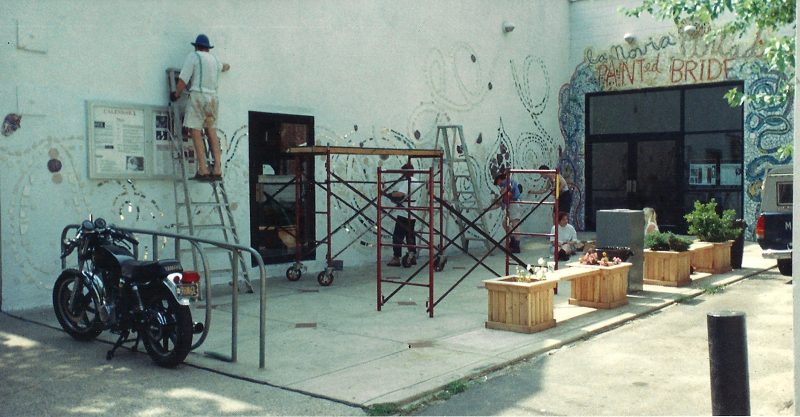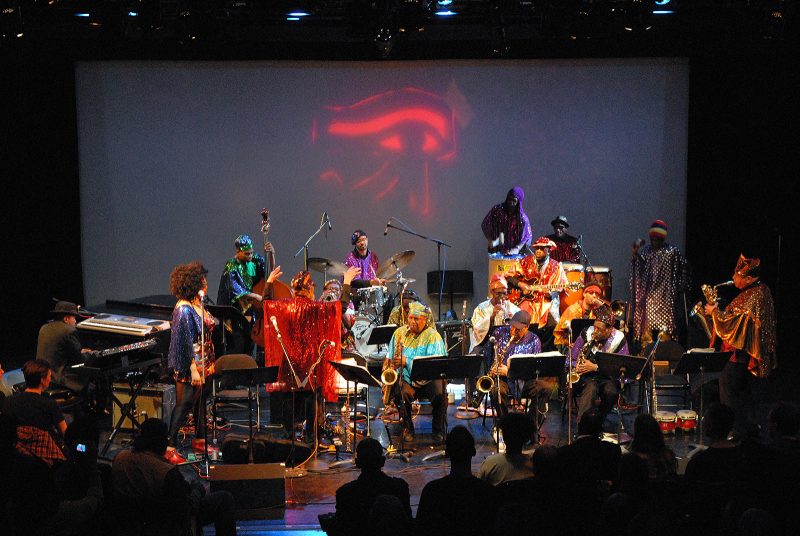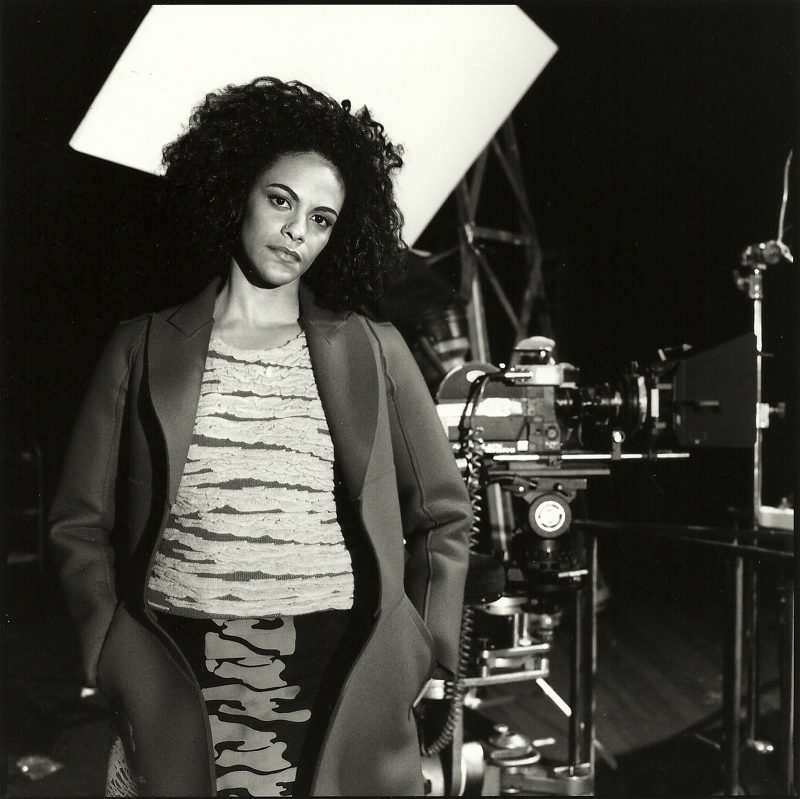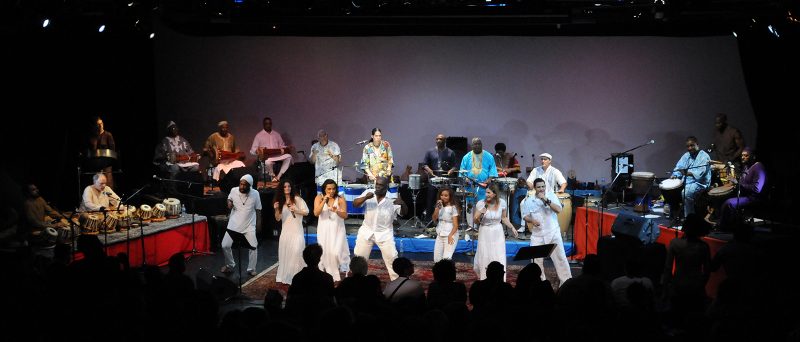After almost 50 years as a supporter of artists, the city’s oldest, mission-driven alternative performing and visual arts venue, the Painted Bride, will no longer have a place to call home. The striking mosaic façade and the building are for sale. The theater that has been filled almost every weekend with edgy and risk-taking dance, theater, music and spoken word performances will be gone.

The Painted Bride as you know it will not exist in the near future. That’s a shock that the local arts community is still trying to wrap their heads around. At this point, there are more questions than answers about the future, but the Bride, or more accurately, the Bride Building, is for sale. The sale is expected to be finalized by June, 2018.
What is not nearly so clear is what form the Bride will take in the future. “Nothing is off the table,” says Executive Director Laurel Raczka, with whom I’ve spoken several times since the announcement was made. What is on the table seems to range from a small staff in an office accepting proposals from artists for a venue and financial support, to a storefront in another neighborhood, apparently, any neighborhood other than Old City.
Passion unleashed – People love the Painted Bride
The passion that this decision has unleashed is one measure of impact the Bride has had over the years.
“They are committing Hari Kari,” railed Jonathan Stein when I talked with him. Stein is a founding board director of the Philadelphia Cultural Fund and nationally respected legal aid attorney.
Many people were surprised to discover the building was up for sale when the Inquirer ran a front-page article in December, 2017. “Painted Bride’s Risky Move” was the original title of Stephan Salisbury’s review of the situation. The Bride had held a “community meeting” for invited guests in May, 2017. There was no mention that the decision had already been made to sell the building.

Terry Fox, a former Bride curator, and well known Philadelphia dancer/choreographer and arts administrator, was at that meeting. She says, “The older generation was appalled and younger people disillusioned,” when they finally heard the news by reading the paper.
The lack of transparency has raised the ire of many committed Bride supporters. Longtime Old City gallery owner, Rick Snyderman is a former board member and his wife, Ruth Snyderman, is currently a member of the Bride’s fundraising committee. Rick published an open letter in thINKingDANCE suggesting that what was needed was “a serious rethinking by the Bride’s board and administrative staff…(that) as stewards of an important legacy may also include turning over that legacy to new leadership…”
Organizational fatigue
The long tenure of the organization’s Executive Director and a few of the board members is unusual. Raczka came to the Bride in 1982 as Program Director and has been Executive Director for the last 25 years. On most non-profit boards, a member serves a term somewhere between two and six years, with three years being a common average. A 2010 survey by BoardSource Nonprofit Governance showed that 70% of non-profit boards have term limits. At least one of the Bride’s board members has been on the board for 15 years.
Other possible ways
Questioning the Bride’s decision to abandon an iconic physical presence is also fueled by the fact that other local arts institutions have decided to move in just the opposite direction.
Philadelphia Contemporary is a new kid in the Philly cultural scene. It was established recently by Harry Philbrick, the former museum director at Pennsylvania Academy of the Fine Arts (PAFA). In its first two years, PC has had success as an itinerant presenter of a bold variety of art events. It presented unique art performances in partnership with venues ranging from a city dump site on the Delaware River to the Barnes Foundation on the Parkway.
In spite of its impressive track record, Philadelphia Contemporary says on its website that it “Plans to have a permanent home as soon as possible for both practical and philosophical reasons. We want to create a sense of community around our projects, a hub where visual, performance, and spoken word artists can interact, and where the public can experience the synergy of different artists working and presenting together.”
Sounds almost like a description of the Bride – at least in earlier years.

One idea to preserve the Bride’s physical presence suggested by Snyderman and other members of the area arts community is partnering with another organization or designing a multi-use building, where several tenants agree to share building costs and some revenues. This successful business model is clearly visible in Philadelphia. The Wilma Theater hosts Ballet X in its Broad Street building. The theater occupies the ground floor with parking on the upper floors. Target offers its shoppers the opportunity to buy new underwear and get a caffeine fix from the Starbucks cafes that are incorporated into its retail stores.
The sale and a building’s deferred maintenance
The Bride purchased its original 11,000 square foot property in 1982 for $325,000. The property now includes three other parcels for a total of 13,600 square feet and was assessed in 2018 for $2,949,800. The sale price will certainly be millions of dollars. Exactly how many millions won’t be known until a developer’s offer is accepted, but one idea is that the sale agreement should include space in the new development for the Bride.
The Bride’s board doesn’t seem to be pushing for a multi-use building proposal from a developer. The focus, instead, is that the sale will provide an infusion of cash for an endowment to support artists, and pay the rent and staff salaries. Without a firm sale price or specific estimates for future costs of staff, rent, and other overhead, it is impossible to estimate what funding will be available for supporting artists.
A leaky roof and the need for millions of dollars in maintenance is one major reason given for selling the building. Joan K. Sloan, Bride Board Chair, is proud that the last fiscal year ended with a balanced budget, but it seems that what helped balance the budget was deferred maintenance, which now, ironically, seems to be a major reason for selling the building.
Dwindling audience
Another issue fundamental to the future of the Bride is its audience or lack of audience. Art, by definition, is fluid, and audiences change, too. In spite of being located in a neighborhood with a huge increase in its residential population, attendance at the Bride has been declining for years. “Our audiences are graying, while younger people are less likely to become subscribers to arts and cultural organizations,” Sloan suggested recently.
Studies conducted by the National Endowment for the Arts suggest that attendance might be more of a Bride problem than a national trend. The NEA did find a significant drop in general attendance in the early part of the 21st century. However, that trend has been reversed in the last few years and “older Americans are the only demographic group to have experienced increases in attending live visual and performing arts activities over the last decade.”
Another marketing study found that Millennials “consider the arts (more) important in places to which they locate” than GenXers, Boomers, or Elders.

Of course, facts and feelings are not the same. Raczka said to me that it feels that after 36 years, “We don’t fit into the Old City neighborhood. It feels weird.”
A consultant and strategic priorities
Figuring out where the Bride fits into the Philadelphia cultural scene seems to be a challenge for the staff and board of the Bride. A “sustainable operation” is the number one “strategic” priority developed recently with the help of a California-based consultant. The list of five Strategic Priorities makes no mention of developing audiences or reaching out to younger people.
As if reinforcing the consultant’s priorities, the planning committee for the Bride’s future did not included young people or new voices from outside the organization. Instead it was comprised of Raczka, three long-time board members, one artist in her 40’s, and former member of the staff who had been with the Bride for ten years.
The good news is that the Strategic Priorities say clearly that “The Bride will design and implement programming that embodies its legacy.” The list goes on to commit to “supporting artists making artwork that engages current issues” and “who undertake creative inquiry and expression that is not confined by the commonly recognized boundaries between arts, sciences and humanities.”
A group of Bride supporters has been talking to developers and exploring alternatives to selling the building. Legal aid attorney and theater/dance advocate Stein told me he thinks “The Painted Bride should pause and give others an opportunity to put together a viable plan for the continuation of a performance venue for dance, theater, music and arts center on the Painted Bride site.” He is confident that “with the right consortium a viable, fundable plan can be put together.”
It may already be too little too late, but if passion counts for anything, pubic opinion may influence the Bride’s future form.

The Bride will present programs at 230 Vine Street through June, 2018. It has also committed to two dance programs for next year although where they will be staged is one more open question. Board Chair Sloan characterizes the Bride programming activity for next year as a “pilot program.”
Can the legacy of the Bride morph into a new dynamic, more agile cultural leadership? That’s the one thing that both critics and supporters hope for. The only thing that is known for sure is that the Bride will be different in the future.
Some lingering questions
The sale price of the building is more than idle curiosity. The decision to sell is based on a plan to establish an endowment that will be invested to secure the Bride’s future. If the sale price is not sufficient to fund a significant endowment, what will become of the Bride and its ability to support artists and future projects.
The Inquirer reported on February 18, 2018, that a 7,840 square foot lot at the corner of 12th and Vine sold for $2.4 million.
Maybe,12th and Vine is not as hot an area as 3rd and Vine (it is coming on strong) but there are other points that make this sale worth noting. First, the sale is for a lot that is five times the size of the Bride property. Second, the buyer holds other adjoining properties. That means they were a motivated to acquire this specific property..
If a motivated buyer was able to acquire a large parcel for only $2.4 million, what does that suggest a developer would pay for a relatively small parcel that offers no special value other than a good location?
Has the Bride leadership established a minimum sale price that would allow the Bride to flourish, at least financially, in the future?
What is the backup plan if that minimum dollar amount (after commissions and taxes) is not obtained?









